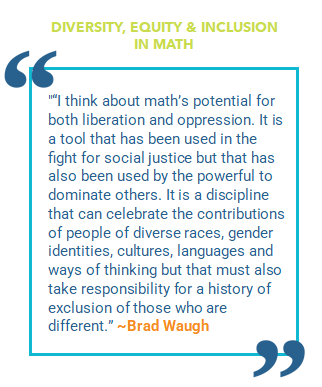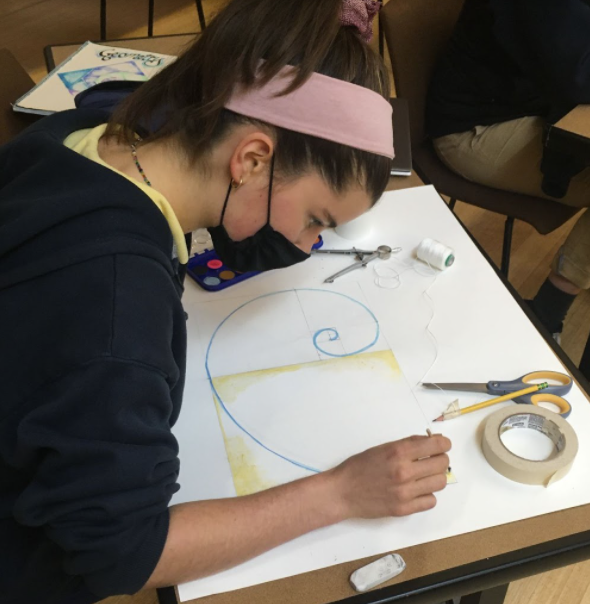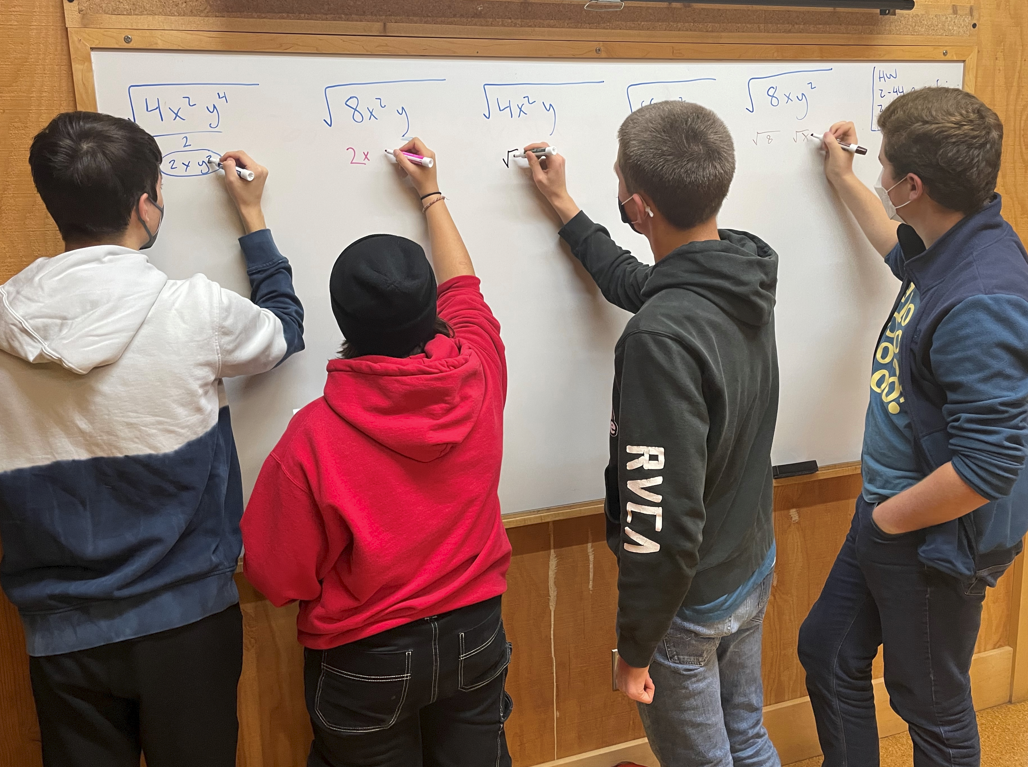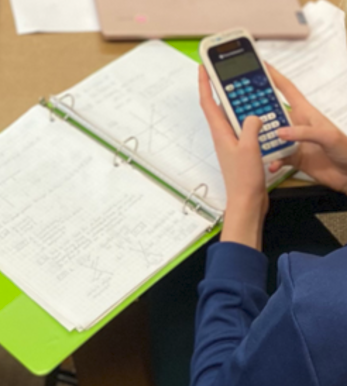Math - Grades 9-12
Math at Hyla is infused with optimism and inclusion. Teachers Brad and Jeanne bring an inspiring enthusiasm to their teaching, and often share inspiration with students, like this quote from Dr. Francis Su, Past President of the Mathematical Association of America and author of Mathematics for Human Flourishing:
“You, as a mathematical explorer who is learning to embrace your Identity in math, can be part of the movement to read people differently. Believe that you and every person in your life can flourish in mathematics."

Foundational principles of our math program include:
- Integrated approach to curriculum and practice.
- Learning in collaboration rather than in competition.
- Mistakes as opportunity for deeper learning and growth.
- Engaging problems rather than drill work.
- Technology as empowerment not as a crutch.
While studying math, Hyla students develop skills that benefit them in all aspects of their lives:
- Conceptual understanding of and procedural fluency in mathematical content.
- Critical thinking, communication, collaboration and creativity.
- Aesthetic appreciation, enjoyment, confidence, persistence and agency as mathematicians & humans.
Our learning and assessment practices include:
- Group learning opportunities: group problem solving, projects and investigations.
- Whole class instruction and discussion to introduce new concepts, vocabulary and problem-solving techniques.
- Timely individualized feedback, support and extensions in-class and during office hours.
- Home learning activities to reinforce concepts and techniques individually and to build confidence.

Math in Action

What are high school math students up to? Designing and constructing works of engineering or art (their choice). Here are some of their projects:
- Designing and artistically rendering a Fibonacci spiral while studying the reality and myths surrounding the role played by the Golden Ratio in art, architecture and nature.
- Establishing a long baseline observation to determine the distance to the moon after learning the geometry of stellar and lunar parallax.
- Analyzing the impact of statistics on professional baseball, from "Moneyball" to the arms race between pitchers and hitters (or as teacher Brad sees it: why baseball isn’t fun anymore).

Working as a collaborative team, high schoolers simplify radicals with these steps: try, present, explore, refine. First, they try to solve the problem independently. Next, they present their approach to classmates. Then they step back to take in the different methods their classmates used. Last, they return to their own work with a new perspective that allows them to refine or reinforce their own approach. If you need to simplify some radicals in your life, grab some friends and get to it!

Hyla teachers will tell you that sometimes the most exciting thing about a new math skill is not necessarily that students learn where and how it can be applied, but that they learn where it cannot. Case in point: finding the best-fit line in algebra class. Students analyze a data sample from a set window of time, find the slope, solve for the y-intercept, and voila: they now have an equation/model they can use to accurately predict results both within and outside of the original data window. While a linear model has far-reaching real-life application (it’s a standard business tool used to show profit over time, for example), what happens next is the best part to Erik. “Once they have the equation in hand, we have a conversation where students determine if that is the best model of that data relationship over time, or whether it’s useful as a predictive tool only in a limited set of circumstances.” Realizing the limitations opens the door to seeing other non-linear data relationships; and discovering such quadratic, exponential or logarithmic models allows students to apply their knowledge into even more complex scenarios in the world around them – like studying population growth in biology class down the hall, or projectile motion in physics class. Beyond high school, students can use non-linear modeling as economists to understand dynamic systems, as epidemiologists to predict pathogen spread, or as structural engineers to prevent resonance in bridge design. So when we see a student finding the best-fit line at Hyla High School, it's exciting to think where this could take them.
Math Classes
In every class taught at Hyla, students have the option to pursue the core pathway (C) or the advanced option (A). Students may also take additional math classes as Electives through Global Online Academy and One Schoolhouse.
Math 100/101: Geometry, Algebra & Statistics
- Core (M 100): Quadratic, square root, cube root, absolute value, trigonometric, piecewise-defined, step, and simple inverse functions. Polygons, circles and solids in Cartesian coordinates; triangles, vectors and trigonometry; Normal distribution and conditional probability and combinatorics.
- Advanced (M 101): In addition to/substitution of core -Non-Euclidean geometry; non-linearity: butterflies, fractals and chaos; and geometry and astronomy: the distance ladder of the universe.
Math 200/201: Algebra, Geometry, Probability & Statistics
- Core (M 200): Rational algebraic, logarithmic and exponential functions; Fundamental Theorem of Algebra and complex roots; transformations of graphs, mathematical inequalities, series, multivariable systems, and trigonometric equations and identities; probability, statistical distributions and sampling variability, including margin of error.
- Advanced (M 201): In addition to /substitution of core: Boolean logic, number theory, matrices and cryptography; celestial mechanics and spherical geometry.
Math 300/301: Advanced Algebra, Trigonometry and Precalculus
- Core (M 300): Functional analysis applied to algebraic, transcendental, inverse and composite functions; conic sections; vectors and matrices; advanced probability; and introduction to concepts in calculus: limits, rates of change and accumulation.
- Advanced (M 301): In addition to/substitution of core: Polar coordinates in the complex plane, roots, Euler equation, Descartes’ method, Vector multiplication, Astrophysics: Orbital dynamics, extrasolar planets and Star Trek.
Math 400/401: Differential and Integral Calculus
- Calculus core (M 400): Limits, continuity conditions, defining and calculating derivatives and integrals, differential equations.
- Advanced (M 401): In addition to core - Improper integrals; Euler’s and Newton’s methods; integration with partial fractions and by parts; arc length; Taylor and Maclaurin Polynomials.
Math 500/501: Statistics & Data Science
- Statistics core (M 450): Descriptive statistics, linear regression, probability and sampling techniques, binomial distributions, experimental design, hypothesis testing, inferential statistics, confidence intervals, and tests of significance; current issues in statistics and data science (data mining and privacy, machine learning algorithms and racism, etc.)
- Advanced (M 451): Increased scope for the independent project, to be decided with student.
